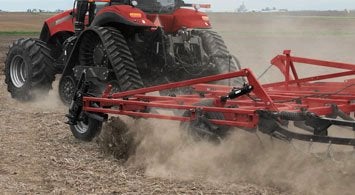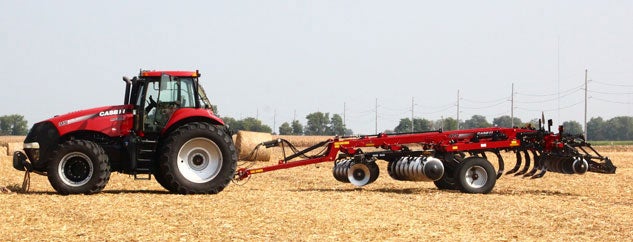
For thousands of years, farmers have prepped their fields for seed planting using the plow. This process known as tilling turns over the upper soil layer and brings nutrients to the surface, buries the previous years’ crop residue to later break down, and mechanically kills weeds. Plows were first made from wood but then later, metallic compositions. Thomas Jefferson studied European plow design, noting their advantages and disadvantages, and coming up with improvements of his own. In 1794, Jefferson fabricated a wooden prototype which led to the manufacture of sturdier cast iron plows. In 1837, John Deere improved on the plow performance by fabricating the plow from polished steel, which was more impervious to soil sticking to it than rougher and more porous cast iron.
This basic concept of prepping the soil continues to this day in a variety of configurations and designs such as the moldboard plow, disc ripper, disc chisel, chisel plow. Up until the late 1940s and early 1950s, most every farm was organic, that is, relying on tilling to control weeds, crop rotation to control nutrient depletion, and using green manure cover crops to improve soil structure and fertility. Soon thereafter, farmers began to use chemicals such as borax and arsenic trioxide to control weed germination and growth. In 1945, the herbicide 2,4-D was introduced. When used in the right concentration, 2,4-D killed most broadleaf weeds by causing an uncontrolled growth that did not affect grasses and planted crops. More powerful herbicides followed, including Paraquat, a desiccant which robs weeds of water and causes them to die, and Dalapan, which accomplished the same by interfering with essential-to-plant-development vitamin B pantothenic acid. Though herbicides are dangerous – as little as a tablespoon of Paraquat is enough to kill a human being – their use flourished.

In 1934, 1936, and again in 1939-1940, skies from the Great Plains to as far away as the East Coast were blackened by clouds of dust. Precipitated by a decade of deep plowing fostered by insufficient understanding of soil ecology and combined with severe drought, the choking clouds of dust, sometimes limiting visibility to as little as a few feet, became known as the Dirty Thirties Dust Bowl. In 1943, the agronomist Edward Faulkner, blamed the then universally used moldboard plow for pillaging the soil. In his book, Plowman’s Folly, Faulkner urged farmers to seek fresh solutions to the problems plaguing modern American agriculture. Faulkner is also credited with the disc plow, which cut up and incorporated fertile organic matter into the soil instead of burying them deep in the subsoil.

In the years since Faulkner’s push for farmers to seek fresh solutions, no-till farming has taken hold. No-till farming uses an air seeder or air drill to punch through the surface residue and deposit the seed at a preset depth. Air seeders are generally large, often 55’ to 60’ wide, and can cover 200 acres a day at speeds of 5-6 mph. Air seeders, especially older units, can have issues with depth consistency – bouncing out of the ground in hard conditions or sinking in soft soil. Air seeders typically fold up for transport. Air drills, on the other hand, are generally smaller, and if they are to make up that reduced coverage productivity, they must do so by operating at increased ground speeds. Air drills are fixed and heavier, requiring more horsepower to pull, and because of their configuration are harder to maneuver during transport.
No-till farming does away with the damage done to soil by tilling, including the erosion caused by wind and water evaporation. Runoff, which carries chemicals such as fertilizers and herbicides, can kill birds and is damaging to water-dwelling organisms, and is nearly eliminated when tilling is. It’s not surprising that no-till farming took hold for ecological reasons. One then might reason that it would be popular with organic farmers. Not so. Without the mechanical weed control associated with tillage, chemicals must step in to do duty. Today, the biggest proponents of no-till farming are agribusinesses specializing in genetically modified crops.

So far, we’ve presented the two sides of till vs. no-till, with the former being a mechanically biocidal method of weed control, and the later replacing the plows and discs with chemicals. We’ll come back to the chemical factors to consider later, but what about cost of till vs. no-till? After all, a farmer must be able to profitably process and bring the crop to market. Generally, it is thought and backed up by many studies, that even if the crop yields remain the same, no-till will be less costly due to reduced runtime hours on equipment and associated manpower requirements. For example, tillage is a multi-step process beginning with a primary till (deeper) and several subsequent secondary (shallower) passes. Each requires tractor(s) and tillage equipment. Each pass burns fuel and takes manpower. No-till does away with that equipment as well as the associated fuel consumption and time it takes to till a field, and reduces ground compaction (all those tillage passes contribute to increased soil compaction). That tillage equipment, though, is now substituted with the need for an air seeder or drill and chemicals.
Weed control in a no-till operation, leans heavily on the application of chemicals. Pre-emergence chemicals are generally applied 10-45 days prior to planting. Spring rains at that time also help activate the herbicides used. Weeds tend to germinate throughout the season, so applications of 2,4-D with or without a burndown herbicide such as glyphosate, and/or paraquat may be required. Post-emergence treatment for johnsongrass, a glyphosate resistant weed, and other nuisances such as fleabane, is required.
Still not sure if switching to no-till is for you? Consider that there will be a steep learning curve with pests, infections, and weeds that are different than in till planted fields. Accurate identification of weed, timing of applications, scouting and monitoring for problems, spot spraying for herbaceous and woody perennials which tend to multiply in no-till fields, maintenance of field rows and borders to keep them clear of aggressive weeds, and assuring an even distribution of residue after harvest are all required.

Other factors to consider are type of crop; for example, root crops such as potatoes work best in fields that are mechanically tilled. Field shape can be a deciding factor, as square fields are easier to till while odd-shaped fields are more difficult and easier to manage if no-till can be incorporated. Soil conditions, such as in geographic regions that are more arid, can be better suited for no-till vs. regions that are wetter and where tilling helps get rid of excess water. Also, crop rotation is important, most experts suggesting no more than two corn-on-corn seasons before a switch. Corn also likes tillage.
Prior to a switch to no-till, it is recommended that you explore all the resources available. Talk to experts at your local (or national) university agronomic program and to neighbors who are successful with no-till growing. And the worldwide web with its host of experience and information is just a finger click away.

No-Till Plusses
- Lessened need for tractors and tillage equipment
- Reduced fuel usage
- Reduced soil compaction
- More planting time flexibility (time interference by springtime tillage needs and weather conditions)
- Great for arid regions
- Soil erosion reduction or elimination
- Reduced runoff and contamination of fields and streams
- Building of a healthy soil ecosystem network (earthworms deposit all kinds of nutrients, but tilling destroys those networks of which their biology must start from scratch each year)
No-Till Minuses
- Additional expensive equipment is required (air seeders and drills partially offset by tractor and tillage equipment reductions)
- Potentially steep learning curve
- Increased chemical usage
- Increased possibility of health-related issues due to chemical exposure (especially when improperly used)
- Might not be the best choice for the type of crop selected
- Might not be the best choice for your region
For those operations that currently till and aren’t convinced change is needed, Faulkner’s cry to seek fresh solutions still holds true. Can you reduce tilling soil disturbance by reducing depth, the number of passes, and the aggressiveness? Is changing to strip-tilling, a conservation methodology that relies on minimal tilling directly at the portion of the soil that is to contain the seed row, or vertical tillage, a method of vertically working the soil, while still not turning over the entire field, a possibility? And lastly, can tillage duties be shifted from a moldboard plow, which leaves less than 15% residue, to a disc ripper, disc chisel or chisel plow, which all double that amount of residue? 
 Your Privacy Choices
Your Privacy Choices